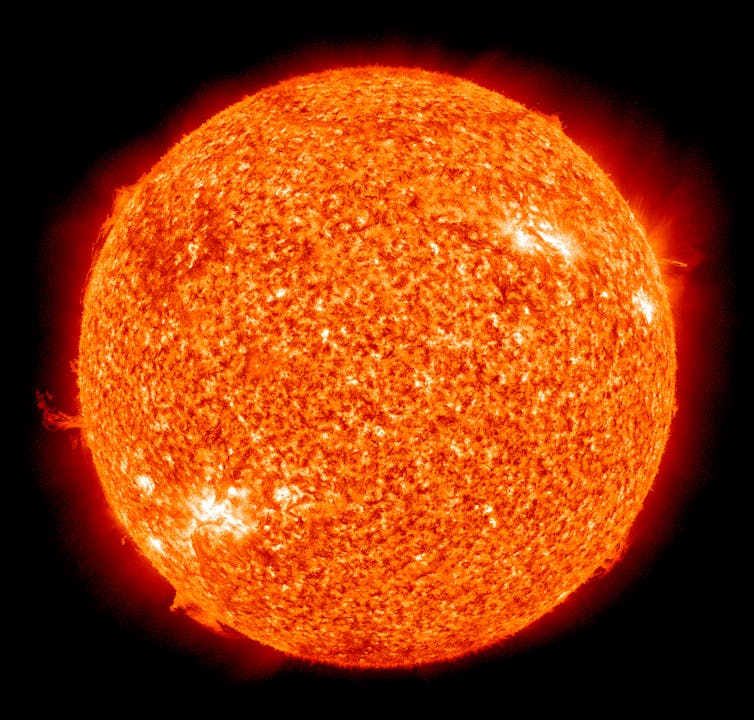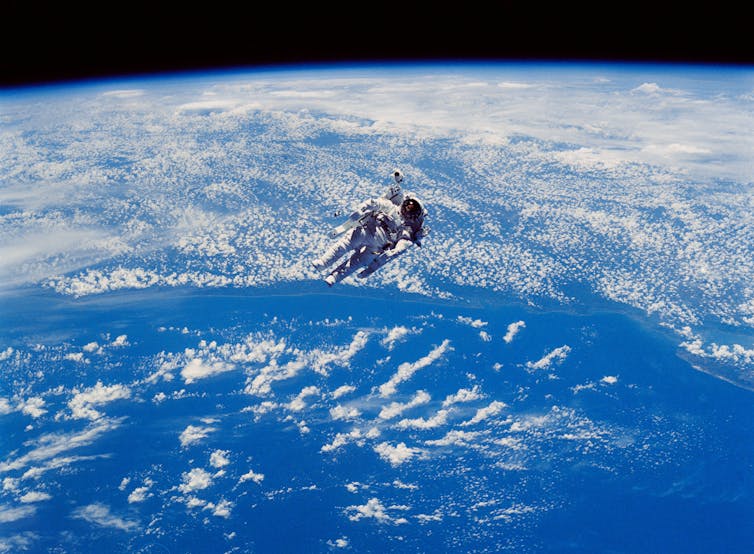From surviving take off to having to rely on oxygen tanks to breathe in orbit, space travel is incredibly risky. But a huge hazard that we sometimes overlook is high energy radiation from sources both inside and outside the solar system.
A new study, published in the journal Space Weather, has shown that radiation received from outside our solar system has been increasing steadily for the last few years, returning to levels not seen since the first half of the 20th century – making space travel more dangerous today than it was during the Apollo era.
This type of radiation, known as “galactic cosmic rays”, consists of the nucleus of an atom travelling very close to the speed of light. These rays, many of which come from our own Milky Way galaxy, are some of the most energetic particles in the known universe and are found throughout the solar system.
Humans have a limited tolerance to radiation of all kinds. Particle radiation can damage DNA in human cells, cause mutations and stimulate cancer. In extreme circumstances, an acute dose of radiation can cause sickness, burns and organ failure. Anyone who works near sources of radiation has a maximum annual limit on the dose they can safely receive.
Solar cycle
In space, astronauts are partially shielded from galactic cosmic rays by the magnetic field of the sun, which deflects some of these incoming charged particles. However, the sun’s magnetic field varies in strength over time, with the 11-year solar activity cycle. At solar minimum (when the sun is least active), the solar magnetic field is weaker, allowing more galactic cosmic rays into the solar system – posing a greater radiation hazard to astronauts. At solar maximum, the opposite is true.

There are natural historical records available for galactic cosmic rays, such as ice core samples at the poles. Specific isotopes (atoms with more or fewer neutrons in the nucleus than their normal counterpart) of Beryllium in such samples – in conjunction with early balloon measurements – show that levels of this radiation were some 50% higher in the first half of the 20th century than they are now.
These higher levels persisted until the mid-1950s – luckily for Yuri Gagarin. He was the first person to go into space in 1961, heralding the era of human spaceflight. The prospect of sending further astronauts into space could have been very different had Gagarin returned with severe radiation poisoning.
The solar cycle itself is also known to vary on longer timescales – so that a series of cycles could be more or less intense than others. The higher levels of galactic cosmic rays that were observed until the 1950s coincided with a period of extended, quiescent, solar activity. These conditions ended abruptly, and coincidentally, at the dawn of the space age. After that, solar activity was higher across several solar cycles, resulting in reduced radiation dangers from galactic cosmic rays for decades.
New data
Since the last solar minimum in 2009, however, the sun appears to have returned to a quieter state once again. In fact, it has not been this quiet since the end of the 19th century. This change appears to be having a strong influence on the level of incoming galactic cosmic rays once again. Since the most recent solar minimum, the new study shows this specific radiation level is on the rise once more – it is currently some 30% higher than it was on average during the latter, quieter, part of the 20th century.
Scientists are currently debating whether these radiation levels will continue to rise. Our lack of knowledge about the underlying science of long-term variation in solar cycles is making it difficult to know for sure. Several studies predict that we are entering a new period of extended solar minimum conditions. But others suggest that current conditions are just part of the normal, long-term variation in solar cycles, and nothing out of the ordinary.
Either way, this evidently has major implications for future manned space missions. Although it is not the only factor to take into account. As well as charged particle radiation from the galaxy, the sun also produces this type of radiation in the form of solar energetic particles, which are produced more often, though not exclusively, at solar maximum.
During the Apollo era, astronauts had a very lucky escape from an unexpected solar storm. In 1972, the sun was heading towards solar minimum. At this time, Apollo 16 and 17 were launched some eight months apart. An unusually strong, and potentially deadly, storm of solar particles were ejected from the sun and enveloped the near Earth environment in the time between these two missions. If either of these expeditions had coincided with this storm, the results could have been fatal.
Protecting astronauts
So with the hazard of this increased particle radiation potentially affecting future human spaceflight, what can we do to counter it? At first glance, it may seem we could simply include more radiation shielding in spacecraft. But there are problems with doing so. Importantly, it adds extra mass, meaning less room for scientific payload and astronaut facilities.

A potential further issue with shielding is that when high energy galactic rays hit a spacecraft, they can produce a shower of further energetic particles and dangerous electromagnetic radiation such as X rays and gamma rays. Modest shielding (for example, aluminium) can provide some protection against low energy cosmic rays. But this extra shielding offers no protection for the astronauts during extravehicular activity, such as space walks, when they are most at risk.
A crucial difference between galactic and solar radiation is that storms of particles from the sun may last for some days, and are much more common at solar maximum. The threat posed by galactic radiation, however, is continuous, with some changes in the level of protection over the course of the solar cycle.
The best way to avoid space-borne particle radiation of all kinds is simply to reduce the exposure to it as much as possible. This means timing missions appropriately to coincide with the balance of solar magnetic field protection and solar energetic particle emission. More importantly, though, reducing the time of flight is the safest option, reducing exposure to both hazards.
In the case of a mission to Mars or beyond, journey times are measured in months or even years. This new study means that mission designers may now have extra safety considerations to make when planning the future of human expeditions to other worlds.

